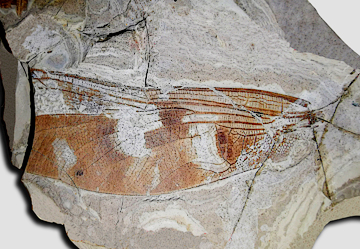Abstract
Mantispidae is a lacewing family with over 400 extant species (Ohl, 2004, 2007; Oswald, 2015). The family is divided into four extant subfamilies Symphrasinae, Drepanicinae, Calomantispinae, Mantispinae and one extinct subfamily Mesomantispinae (Lambkin, 1986a, b; Wedmann & Makarkin, 2007). The living mantispids are distributed cosmopolitan except Antarctica. Fossil mantispids have been recorded since Early Jurassic (Ansorge & Schlüter, 1990; Wedmann & Makarkin, 2007; Khramov, 2013; Jepson et al., 2013, 2018a, b; Shi et al., 2019). The fossils are mainly from the Eurasia, with exception of two Miocene genera from Mexican and Dominican (Engel & Grimaldi, 2007).
References
Ansorge, J. & Schlüter T. (1990) The earliest chrysopid: Liassochrysa stigmatica n .g., n. sp. from the Lower Jurassic of Dobbertin, Germany. Neuroptera International, 6, 87–93.
Cruickshank, R.D. & Ko, K. (2003) Geology of an amber locality in the Hukawng Valley, northern Myanmar. Journal of Asian Earth Sciences, 21, 441–455.
https://doi.org/10.1016/S1367-9120(02)00044-5
Enderlein, G. (1910) Klassifikation der Mantispiden nach dem material des Stettiner Zoologischen Museums. Stettiner Entomologische Zeitung, 71, 341–379.
Engel, M.S. & Grimaldi, D.A. (2007) The neuropterid fauna of Dominican and Mexican amber (Neuropterida: Megaloptera, Neuroptera). American Museum Novitates, 3587, 1–58.
https://doi.org/10.1206/0003-0082(2007)3587[1:TNFODA]2.0.CO;2
Grimaldi, D., Engel, M.S. & Nascimbene, P. (2002) Fossiliferous Cretaceous amber from Myanmar (Burma): its rediscovery, biotic diversity, and paleontological significance. American Museum Novitates, 3361, 1–72.
https://doi.org/10.1206/0003-0082(2002)361<0001:FCAFMB>2.0.CO;2
Jepson, J.E., Heads, S.W., Makarkin, V.N. & Ren, D. (2013) New fossil mantidflies (Insecta: Neuroptera: Mantispidae) from the Mesozoic of north-eastern China. Palaeontology, 56, 603–613.
https://doi.org/10.1111/pala.12005
Jepson, J.E., Khramov, A.V. & Ohl, M. (2018a) New Mesomantispinae (Insecta: Neuroptera: Mantispidae) from the Jurassic of Karatau, Kazakhstan. Zootaxa, 4402, 563–574.
https://doi.org/10.11646/zootaxa.4402.3.9
Jepson, J.E., Khramov, A.V. & Ohl, M. (2018b) A substitute name for a genus of fossil mantispid (Insecta: Neuroptera: Mesomantispinae) from the Jurassic of Kazakhstan. Zootaxa, 4455, 400–400.
https://doi.org/10.11646/zootaxa.4455.2.10
Khramov, A.V. (2013) New mantidflies (Neuroptera: Mantispidae) from the Upper Jurassic of Kazakhstan. Insect Systematics & Evolution, 44 (2), 221–230.
https://doi.org/10.1163/1876312X-44032094
Lambkin, K.J. (1986a) A revision of the Australian Mantispidae (Insecta: Neuroptera) with a contribution to the classification of the family. I. General and Drepanicinae. Australian Journal of Zoology, Supplementary Series, 116, 1–142.
https://doi.org/10.1071/AJZS116
Lambkin, K.J. (1986b) A revision of the Australian Mantispidae (Insecta : Neuroptera) with a contribution to the classification of the family. II. Calomantispinae and Mantispinae. Australian Journal of Zoology-Supplementary Series, 117, 1–113.
https://doi.org/10.1071/AJZS117
Leach, W.E. (1815) Entomology. In: Brewster, D. (Ed.), Edinburgh Encyclopaedia 9. W. Blackwood, Edinburgh, 57–172.
Linnaeus, C. (1758) Systema naturae per regna tria naturae, secundum classes, ordines, genera, species, cum characteribus, differentiis, synonymis, locis. Tom. I. Editio decima, reformata. L. Salviae, Holmiae [= Stockholm], [4] + 824 pp.
https://doi.org/10.5962/bhl.title.542
Liu, X.Y., Winterton, S.L., Wu, C., Piper, R. & Ohl, M. 2015. A new genus of mantidflies discovered in the Oriental region, with a higher-level phylogeny of Mantispidae (Neuroptera) using DNA sequences and morphology. Systematic Entomology, 40, 183–206.
https://doi.org/10.1111/syen.12096
Makarkin, V.N. (1990) New lacewings (Neuroptera) from the Upper Cretaceous of Asia. In: Akimov, I.A. (Ed.), News of faunistics and systematics, Naukova Dumka, Kiev, 63–68 [In Russian].
Makarkin, V.N. & Menon, F. (2005) New species of the Mesochrysopidae (Insecta, Neuroptera) from the Crato Formation of Brazil (Lower Cretaceous), with taxonomic treatments of the family. Cretaceous Research, 26, 801–812.
https://doi.org/10.1016/j.cretres.2005.05.009
Ohl, M. (2004) Annotated catalog of the Mantispidae of the World (Neuroptera). Contributions on Entomology, International, 5, 131–262.
Ohl, M. (2007) Toward a global inventory of Mantispidae—the state-of-the-art in mantispid taxonomy. Annali del Museo Civico di Storia Naturale di Ferrara, 8[2005], 79–86.
Oswald, J.D. (2015) Neuropterida Species of the World. Version 4.0. Available at: http://lacewing.tamu.edu/SpeciesCatalog/Main (Accessed 7 June 2019).
Panfilov, D.V. (1980) New representatives of lacewings (Neuroptera) from the Jurassic of Karatau. In: Dolin, V.G., Panfilov, D.V., Ponomarenko, A.G. & Pritykina, L.N. (Eds), Fossil insects of the Mesozoic, Naukova Dumka, Kiev, 82–111 [In Russian].
Poinar, G. & Buckle, R. (2011) Dortomantispa burmanica n. gen., n. sp. (Neuroptera: Mantispidae), a new genus of mantidflies in Burmese amber. Historical Biology, 23, 169–176.
https://doi.org/10.1080/08912963.2010.505024
Shi, C.F., Yang, Q., Winterton, S.L., Pang, H. & Ren, D. (2019) Stem-group fossils of Symphrasinae shed light on early evolution of Mantispidae (Insecta, Neuroptera). Papers in Palaeontology, 2019, 1–12.
https://doi.org/10.1002/spp2.1265
Shi, G.H., Grimaldi, D.A., Harlow, G.E., Wang, J., Wang, J., Yang, M.C., Lei, W.Y., Li, Q.L. & Li, X.H. (2012) Age constraint on Burmese amber based on U-Pb dating of zircons. Cretaceous Research, 37, 155–163.
https://doi.org/10.1016/j.cretres.2012.03.014
Wedmann, S. & Makarkin, V.N. (2007) A new genus of Mantispidae (Insecta: Neuroptera) from the Eocene of Germany, with a review of the fossil record and palaeobiogeography of the family. Zoological Journal of the Linnean Society, 149, 701–716.
https://doi.org/10.1111/j.1096-3642.2007.00273.x
Zhao, Z.P., Yin, X.C., Shih, C.K., Gao, T.P. & Ren, D. (2019) Termite colonies from mid-Cretaceous Myanmar demonstrate their early eusocial lifestyle in damp wood. National Science Review, nwz 141.

